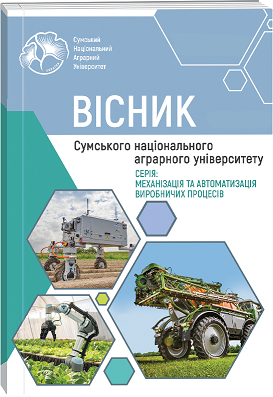DETERMINATION OF CIRCULAR HARDNESS OF TRACTOR ATTACHMENT SYSTEM DURING TECHNOLOGICAL OPERATION
Abstract
The article considers the issues of determining the circular stiffness of the tractor hitch system. Modern attachment systems have a fairly simple, but at the same time complex system of connecting an agricultural machine to the power tool. The attachment system is a hinge-lever mechanism located at the rear or front of the tractor. Quite often all-terrain tractors have both attachments. Their functions are almost the same, but the weight of the machines that are combined with the tractor are slightly different. It all depends on how the machine is attached to the tractor. Traditionally, mounted machines are placed on both attachments, but on the front – placed lighter machines. This is due to the lower load capacity of the tractor’s front axle, plus the need for a good front view from the tractor cab. Regarding the rigidity of the hinged system, we can say that such studies are extremely few. The fact is that the design of the hitch itself is massive and such that there is no doubt about its reliability. However, modern agricultural machinery, which has a width of 8 meters or more, has a significant weight compared to other equipment with a smaller width. Therefore, there is a legitimate question about the rigidity and bearing capacity of tractor hitches. The presented article considers the theoretical issue of determining the rigidity of the tractor hitch system during the technological operation of sowing crops. The determined theoretical dependences show the change in the value of the angle of deviation of the drill from the trajectory of the tractor. The obtained theoretical equations can be useful in the design of mounted agricultural machines. The task is to determine the relationship between the elastic tension of the chain and the angle of rotation of the drill. To do this, consider the quadrilateral, which symbolizes the mounted system, where some hinges are the points of attachment of the lower links to the lower axis of the tractor hitch, and others – the points of attachment to the drill. Dashed lines indicate elastic elements – limiting chains. At the same time we will be interested in the angles of rotation of the drill relative to the tractor, and the angle of rotation of the lower link of the hitch. The conducted theoretical researches have shown the significance of the stiffness index of tractor hitches. The obtained dependence showed that the main indicators in determining the stiffness are the moment of the elastic force of the limiting chain and the angle of rotation of the lower rod of the hitch mechanism. In turn, the strength of the elasticity of the limiting chain depends on the material from which it is made, and the service life of the entire hinged system.
References
2. Semenov V. M. (1981). Rabota na traktore [Working on a tractor]. Moskva : Kolos. 271 p. (in Russian).
3. Hrechkosiy V. D. (1988). Dovidnyk sil’s’koho inzhenera [Handbook of rural engineer]. Kiev : Urozhay. 360 p. (in Ukrainian).
4. Makarenko M. H. (2012). Navisni systemy traktoriv [Tractor mounted systems]. Kiev : Mechanization of agro-industrial complex. № 6. Pp. 20–24. (in Ukrainian).
5. Pavlyuk A. S., Kalinin R. A. (2009). Povysheniye ustoychivosti i upravlyayemosti mobil’nykh mashin za schet konstruktsii tyagovo-stsepnogo ustroystva [Improving the stability and controllability of mobile machines due to the design of the towing device]. Yekaterinburg : Polzunovskiy vestnik. № 1-2. Pp. 119–122. (in Russian). 6. Popov V. B. (2008). Avtomatizirovannoye proyektirovaniye mekhanizma naveski perednego podyemno-navesnogo ustroystva universal’nogo yenergosredstva [Computer-aided design of the linkage mechanism of the front lifting-hinged device of a universal power source]. Minsk : Mekhanizatsiya i elektrifikatsiya sel’skogo khozyaystva: mezhvedomstvennyy tematicheskiy sbornik. Vyp. 42. pp. 3–12. (in Belarussian).
7. Artobolevskiy, I. I. (1988). Teoriya mekhanizmov i mashin [Theory of mechanisms and machines]. Moskva : Mashinostroyeniye. 640 p. (in Russian).
8. Guskov, V. V. (1981). Traktory. Chast 3. Konstruirovaniye i raschet [Tractors. Part. 3. Design and calculation]. Minsk : Vysshaya shkola. 383 p. (in Russian).
9. Vodyanyk I. I. (1994). Ekspluatatsiyni vlastyvosti traktoriv i avtomobiliv [Performance properties of tractors and cars]. Kiev : Urozhay. 224 p. (in Ukrainian).

 ISSN
ISSN  ISSN
ISSN 



